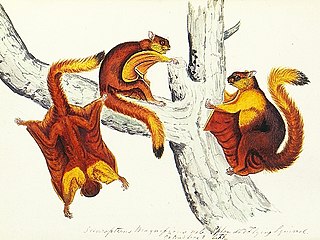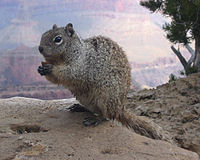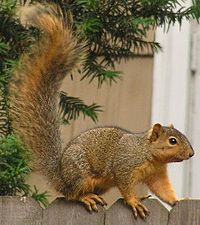
Squirrels are members of the family Sciuridae, a family that includes small or medium-sized rodents. The squirrel family includes tree squirrels, ground squirrels, and flying squirrels. Squirrels are indigenous to the Americas, Eurasia, and Africa, and were introduced by humans to Australia. The earliest known fossilized squirrels date from the Eocene epoch, and among other living rodent families, the squirrels are most closely related to the mountain beaver and dormice.

Flying squirrels are a tribe of 50 species of squirrels in the family Sciuridae. Despite their name, they are not in fact capable of full flight in the same way as birds or bats, but they are able to glide from one tree to another with the aid of a patagium, a furred skin membrane that stretches from wrist to ankle. Their long tails also provide stability as they glide. Anatomically they are very similar to other squirrels with a number of adaptations to suit their lifestyle; their limb bones are longer and their hand bones, foot bones, and distal vertebrae are shorter. Flying squirrels are able to steer and exert control over their glide path with their limbs and tail.

Sciurinae is a subfamily of squirrels, uniting the flying squirrels with certain related tree squirrels. Older sources place the flying squirrels in a separate subfamily (Pteromyinae) and unite all remaining sciurids into the subfamily Sciurinae, but this has been strongly refuted by genetic studies.

The Anomaluridae are a family of rodents found in central Africa. They are known as anomalures or scaly-tailed squirrels or [African] flying squirrels. The six extant species are classified into two genera.

The squirrel glider is a nocturnal gliding possum. The squirrel glider is one of the wrist-winged gliders of the genus Petaurus.

The Mentawai Islands rain forests is a tropical moist broadleaf forest ecoregion in Indonesia. It covers the Mentawai Islands, an archipelago in the Indian Ocean off the west coast of Sumatra. The islands have been separated from Sumatra since the mid-Pleistocene period, and their geographic isolation allowed the evolution of several endemic species, including 17 endemic mammals.

The flying mice, also known as the pygmy scaly-tails, pygmy scaly-tailed flying squirrels, or pygmy anomalures are not true mice, not true squirrels, and are not capable of true flight. These unusual rodents are essentially miniaturized versions of anomalures and are part of the same sub-Saharan African radiation of gliding mammal.

Hylopetes is a genus of flying squirrels. There are about 10 species.
Pygmy flying squirrels (Petaurillus) are a genus of flying squirrels.

The black flying squirrel or large black flying squirrel is a species of rodent in the family Sciuridae. It is found in Brunei, Indonesia, and Malaysia; its habitat is primary and secondary forests and gardens where it uses tree hollows. It feeds on fruits, nuts and other vegetable matter. It is likely not threatened and is adaptable to habitat loss. Black flying squirrels tend to have smaller populations than other squirrels because female black flying squirrels breed infrequently and have a small litter size of just one young.

The Javanese flying squirrel is a species of rodent in the family Sciuridae. It is found in Indonesia, Malaysia, and Singapore.
The Mentawi flying squirrel is a species of rodent in the family Sciuridae. It is endemic to Indonesia where it is only known from the Mentawai Islands. Its natural habitat is lowland tropical primary forest below 500 m (1,600 ft) above sea level. It is threatened by habitat loss.

Petaurista is a genus of rodent in the family Sciuridae. They are large to very large flying squirrels found in forests and other wooded habitats in southern and eastern Asia.

The spotted giant flying squirrel, also known as the lesser giant flying squirrel, is a species of rodent in the family Sciuridae. It is found in hill and mountain forests at altitudes of 200–4,000 m (660–13,120 ft) in Southeast Asia north to central China and the east Himalayan region, although the northern populations sometimes are regarded as separate species as the grey-headed giant flying squirrel, Chindwin giant flying squirrel and P. marica. Two of these, as well as a few other populations, lack the white spots on the upperparts for which it is named. Although a large flying squirrel, it is a relatively small giant flying squirrel.

Hodgson's giant flying squirrel is a species of rodent in the family Sciuridae. This large flying squirrel lives in Himalayan forests in Asia. Like other flying squirrels, it is nocturnal and able to glide long distances between trees by spreading out its patagium, skin between its limbs.

The Indian giant flying squirrel, also called the large brown flying squirrel or the common giant flying squirrel, is a species of rodent in the family Sciuridae. It is capable of gliding flight using a skin membrane, the patagium, stretched between front and hind legs. It is found in mainland Southeast and South Asia, and southern and central China.

Petinomys is a genus of flying squirrels. They are known commonly as the dwarf flying squirrels.
The Himalayan large-eared flying squirrel is a species of flying squirrel found in southwestern Yunnan Province, China, and adjoining Myanmar. It is the only member of the genus Priapomys.


















